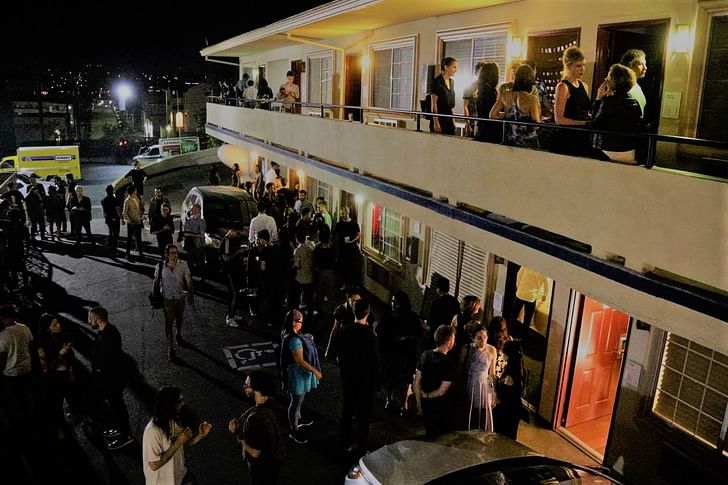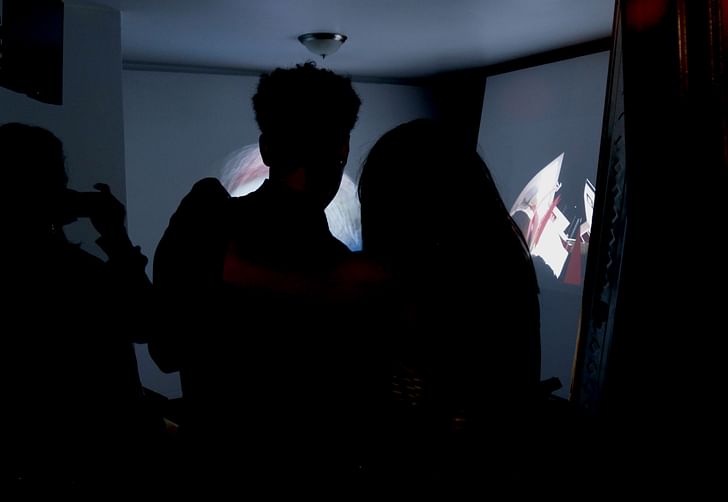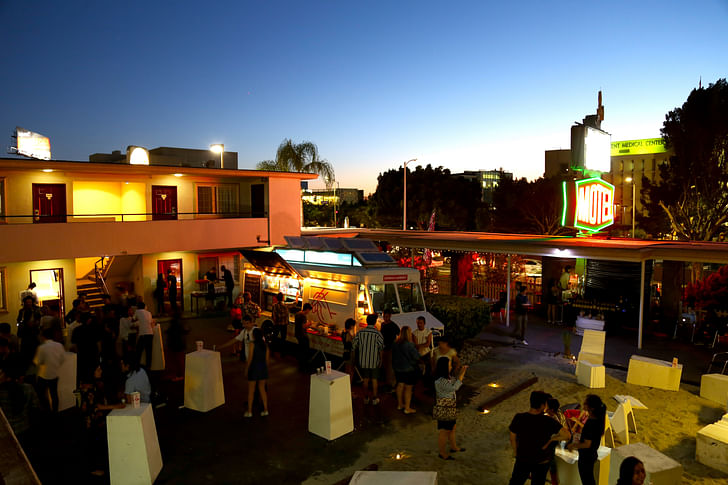

On May 20th, the third and final iteration of One-Night Stand for Art and Architecture (ONS-LA)—a popular annual event in Los Angeles where designers transform motel rooms into installations for the night—took over the Royal Viking Motel in Los Angeles’ MacArthur Park. Over the course of its three year run, ONS-LA has established itself as a dynamic platform for alternative architectural production, exhibition and engagement. It’s also very fun. After all, how often do architects get to have a party of their own?
While the theme and structure of the event stayed loyal to its precedents, the overall body of work appeared to have a different character. If last year’s show was geared more towards interactive works, this year’s projects seemed to resist more immersive experiences for the visitor and instead engaged mainly with mediums and materials, from lights and projections to digital representations and performances. With 20 participants and 18 rooms, the projects displayed a wide variety in their approach. Some installations seemed to represent the designers’ reflections on the motel site as they riffed on the dizzying familiarity of its objects, while others presented spatial manifestations of individual pursuits and curiosities (that is to say, adaptations of personal projects reinterpreted for this event).
As you enter, the first room you stumble upon is, basically, a messy pile of objects ranging from cans of spray and Gorilla glue to ladders and fake grass. As visitors pass by the roped off room, more than a few giggle and comment on the similarities to their college dorm. Clark Thenhaus’ playful and ironic installation dances around the concepts behind (above and under) architectural installation, allowing one to ponder the work’s significance as much or as little as desired—after all, as the piece is called, it’s Just Stuff In A Room, Anyway.
one [could] ponder the work’s significance as much or as little as desired
A couple of rooms over, about thirty unwanted, Craigslist-sourced lamps gathered in a communal effort to light up the room and narrate their candid origin stories by way of their ads hung on the wall. In a sly and humorous way, Marshall Ford’s installation was also intended to reference LA’s most photogenic installation: Chris Brown’s Urban Lights at the Los Angeles County Museum of Art.


A floor above, Christina Novakov-Ritchey passionately beat dirt out of a transparent punching bag. The performance piece titled Labors of Land was done in collaboration with Zachary Tate Porter and Mari Beltran and comprised a video-narration about Stella Obst, the female secretary for the Olmsted Brothers during the early 20th century when the firm, composed entirely of men, traveled out to California to survey and design Palos Verdes. Probably the most unexpected, and perhaps the least “architectural” of the bunch, it nevertheless offered a refreshingly nuanced story touching upon issues of gender dynamics, socio-economic stratification and disciplinary expertise, while simultaneously engaging the space at its full capacity. Somewhere down the hall, Sofia Blance’s white inflatables and blue projections imitated “a house on a pool”. The piece was inspired by the symbolic and complex relationship pools have with Los Angeles. It also doubled as a bouncy castle, to the delight of the few kids whose parents dragged them along.
a part of the ONS-LA’s main appeal is precisely this lack of a conceptual framework
Among the most eye-catching projects of this year’s event was a massive black rock that nearly occupied an entire room. While its intention as a metaphor for the decline of the middle class would be missed by most, Mircea Eni’s Don’t Mind The Rock looked so uncanny that its overwrought conceptualization faded into the background. Further along, Michael Zimmerman installed Fuzzy Edges, which, unsurprising considering its name, comprised fuzzy material draped around the framed entrance and prints of fur replacing the original artworks of the motel. On the other side of the motel, past an interactive light installation, a large and very sandy courtyard was occupied by a food truck and cornered by a bar in a laundry room.

Each of the projects was dramatically different and, while such diversity in approach can be captivating, beyond the desire to come out and produce physical work there appeared to be no overarching ideas holding the show together. Ryan Martinez, who created the yearly spectacle said, “The position is to do work, and to give people who are very talented an opportunity to do work, to operate under one umbrella.” In fact, a part of the ONS-LA’s main appeal is precisely this lack of a conceptual framework. It brings out the individuality of its participant, with the context of the motel acting as the only unifying force. Diverse and hard to summarize, ONS-LA acts as “a google version of architecture”—as Anthony Morey, one of the founders of the event states—, free of the burdens that historical importance and the bubble of academia often impose on exhibitions of work. As an arena for the architecture community to come together and showcase work without taking itself too seriously, it is both rare and welcome.

Morey commented that it would be ONS’ last rendezvous for two reasons: “We observed that the show was running its course. The first year was very strong as it wasn’t a 'known thing' yet. The second was cornering of the previous one. This time the work seemed to fall in-between, not really making a stance on what it was. Its less-provocative outcomes pointed out to what the general discipline expects installations to be: lost. Across the discipline, the urge to fulfill a requirement has replaced the desire for a stance or agenda. That lack of emotion was powerful to see. We got the most out of it, without becoming a commentary on ourselves. It was short enough to have precedent but not long enough to have history — an interesting point to conclude at.”
A One-Night Stand for Art & Architecture (One-Night Stand LA) is a non-profit event and publication project by a group of emerging architects and artists exploring different forms of media, but also new possibilities for strategies of subversion. The Los Angeles-based event was initiated as a means for fostering the emerging creative eruptions in the disciplines of art and architecture. The group uses motel rooms for one night, and one night only to exhibit work.
The event was co-founded by William Hu, Ryan Tyler Martinez, & Anthony Morey in 2015. The curators of Last Call were Volkan Alkanoglu, Jennifer Bonner and Kyle Miller.
A designer & writer based in Los Angeles anastasiatokmakova.comyouthartsclub.com
1 Featured Comment
As one of the founders of ONS-la mentioned in the article, a huge amount of credit is due to the curators of this years event, Volkan Alkanoglu, Jennifer Bonner and Kyle Miller. Without them, the show would not have been what it was. THANK YOU!
All 2 Comments
Is the barefoot individual in the third photo by Kristen Chon, (part of) one of the installations as well...?
As one of the founders of ONS-la mentioned in the article, a huge amount of credit is due to the curators of this years event, Volkan Alkanoglu, Jennifer Bonner and Kyle Miller. Without them, the show would not have been what it was. THANK YOU!
Block this user
Are you sure you want to block this user and hide all related comments throughout the site?
Archinect
This is your first comment on Archinect. Your comment will be visible once approved.